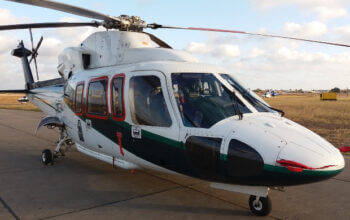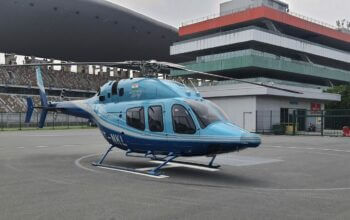Estimated reading time 18 minutes, 20 seconds.
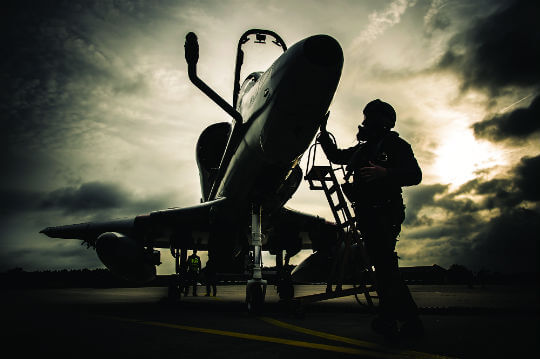
Olaf Tutay checks his A-4N before going up against Luftwaffe EF2000s.
The glossy brochures state that it is “changing the face of air combat training.” That’s quite a claim. But any engagement with Canada’s Discovery Air Defence—whether from inside the cockpit of your fighter, sitting behind an executive desk or getting elbow-deep in an airframe behind hangar doors—will quickly reveal that this statement is more than just a slick piece of marketing jargon.
There’s a crop of pretty high-profile companies now offering contracted defence services, flying fleets of legacy third-generation aircraft on a plethora of missions from ramps all over North America. So, what makes DA Defence different?
With more aircraft and personnel than most air forces, more “top guns” than their home nation’s military, the industry’s first multi-national contracts played out in three countries across two continents, multiple regulatory bodies satisfied, and ambitious plans to become the first civilian operator of the F-16 Fighting Falcon to compete in the Fifth Generation pilot training arena, DA Defence is as dynamic as the world of air combat itself.
Elmar Besold is DA Defence’s chief fighter pilot at Wittmund. He has been very impressed with the new operations.
The company recognized at an early stage that the aggressor-based air support to defence operational training (ASDOT) market was working well within North America, yet Europe had not really caught up with its benefits.
Europe’s longest-standing defence contractor provider was BAE Systems, operating out of Wittmund air base in Lower Saxony, Northern Germany, flying aggressor and target-tug duties for the Luftwaffe. That company operated the Luftwaffe contract for decades, first flying F-100 Super Sabres before moving to A-4 Skyhawks. But, when the last five-year contract went to tender last year, the ASDOT industry had shifted up a gear. DA Defence seized its chance and the differences it is bringing to the table are worlds apart, as it looks to turn its first German step into a European leap.
Rolf Brandt is a progressive ex-Luftwaffe Tornado electronic combat/reconnaissance weapons system officer (ECR WSO) who retired in 2006. Operating as DA Defence’s new business development lead for Europe, Brandt’s knowledge about the fighter pilot world and the defence contractor industry is as infectious as his enthusiasm for DA Defence and its potential over the Atlantic. 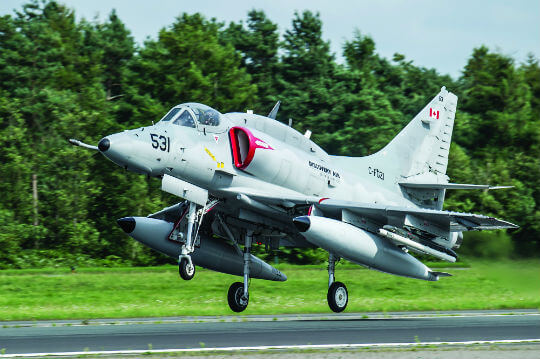
Flight’s on! A DA Defence A-4N heads out for another sortie in support of Luftwaffe EF2000 fighter pilot training over northern Germany.
“The German contract covers 1,200 hours of air force, army and navy duties, with about 85 per cent falling to the air force,” he explained to Skies. “We deliver this in line with the Department of National Defence safety guidelines as well as those of Transport Canada, for both aircraft operation and their maintenance, so the customer is getting the best of both worlds.”
His comment is a nod to the extensive hoops that the company jumped through to get U.S. and Canadian military and civilian certification. Germany’s own War Weapon Control Act further compounded the situation. “We perform our own engineering and our own maintenance on our own planes—the full spectrum from top to bottom is all in our hands,” Brandt continued.
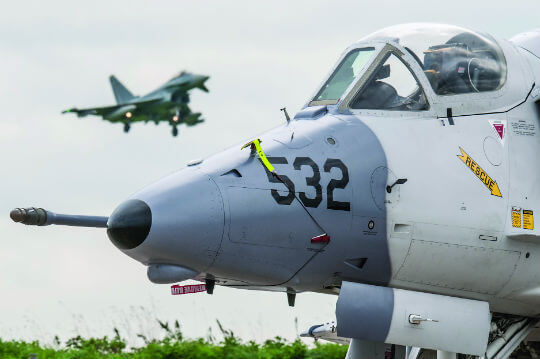
The A-4N is a tough opponent for the EF2000s, but the company is eagerly anticipating the expected arrival of F-16 Fighting Falcons.
A-4 Operations
The new European era of ASDOT became a reality in January 2015, when DA Defence commenced the five-year contract to supply the German military with forward air controller (FAC) and aggressor training, target towing and naval protection profiles amongst other roles, with an initial fleet of seven Douglas A-4N Skyhawks.
The first of these touched down at Wittmund in November 2014, as DA Defence geared up its operations and previous contractor BAE Systems ran its down. There was no honeymoon period of smooth transition. BAE Systems provided a service up to Dec. 31, and DA Defence started its work on Jan. 1, 2015 in a clean cut.
Global logistics supplier GTE acted as a strategic partner in the move, on hand to demonstrate German industry and thinking styles, and DA Defence now has 26 employees in the country. These include five highly experienced German pilots (three ex-Phantom and two ex-Tornado, all ex-BAE Systems employees). A sixth pilot was being recruited at the time of writing, and there are two Canadian pilots on standby for human/operational factors. The maintenance lead must be a Canadian under the stringent regulations.
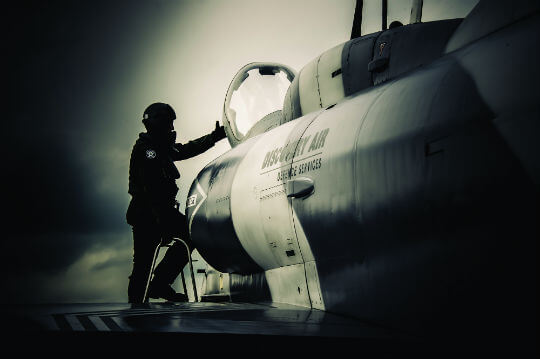
The “right people” are key to DA Defence’s operations.
The most challenging part of fulfilling the contract is the demand for aircraft availability. DA Defence can be tasked with up to 12 sorties every day, and it has to be able to provide six aircraft a day—an aggressive target that it is working hard to reach by matching its flight hours to an efficient maintenance schedule. Indeed, the fleet flew 174 hours in July alone. After a delay, it is hoped the seventh aircraft will arrive before the end of the year to aid in reaching the target of six jets on the line.
The Canadian head office maintains direct supervision, but with a welcome, well-managed light-touch policy. “In the beginning, the control was pretty tight. But now, with normal duties and the results we are delivering, our Canadian friends are satisfied with what we are doing and the reigns are loose, all whilst overseeing that we are delivering the contact requirements,” explained a company spokesman in Germany. “We talk to Montreal once a week with our chief operations officer, discussing any budget or solution requirements, but the trust is there and it’s a very good working relationship. The message we have is that what we are doing here in Germany is correct.”
The enigmatic chief pilot at the company’s Wittmund base is Elmar Besold, a fighter pilot to the core. Having also worked as chief pilot for BAE Systems, he is well placed to compare the service delivery of the two companies.
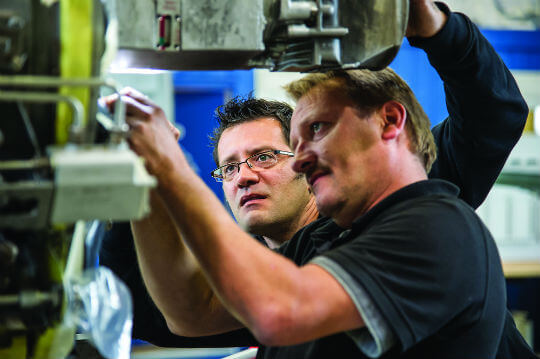
DA Defence prides itself on its maintenance standards. Indeed, the company claims that along with certification, overhaul and upgrade, its maintenance capabilities set it apart from the competition.
As a pilot going to work every day, Besold has noticed a difference over the BAE Systems days. “The thing that strikes me the most is the level of motivation in the leadership,” he said. “First of all, it is a very flat hierarchy. If I need the boss of the whole company, I can just pick up the phone. Everyone is positive, always interested and we have very close communication ties.
“Another big difference is the in-house cockpit upgrade. This has resulted in the best cockpit installed in any defence contractor asset anywhere in the world.”
Patrick Blois, a Canadian from Halifax, N.S., is part of the small team with a big punch that’s responsible for the ultra-high maintenance standards for DA Defence. Blois put the wrenches down to explain how it works.
“Since these are Canadian-registered aircraft, the laws require that they must be signed off by a Canadian national, so I am one of three Canadian-licensed aircraft maintenance engineers here at Wittmund,” he said.
“I arrived in Germany in November 2014. I moved my family over here, too, moving to the nearby town of Wilhelmshaven. My family thinks it’s great; it’s going well. The language has been hard, but the people in the area know us now and we are all making an effort to bridge the language barrier.”
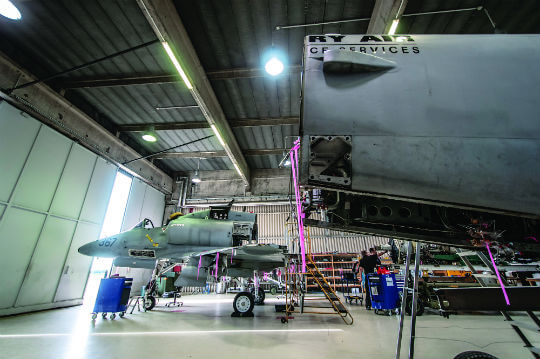
Since the A-4Ns are Canadian-registered aircraft, they must be signed off by a Canadian national. DA Defence has therefore moved three Canadian aircraft maintenance engineers to Germany.
He said the German contingent is in contact with the company’s Montreal headquarters on a daily basis in order to provide aircraft status reports. “These jets are high maintenance [the highest time is around 4,500 hours, the lowest around 2,000 hours], certainly more than the Alpha Jets we have, and even adding oil to the engine is a two-man job. It’s not difficult, but it has to be done right.”
Blois said all maintenance is done in Wittmund, although engines are shipped to Safe Air of New Zealand for overhaul. In terms of hardware, there are specialists to work on target-tow equipment and the dummy bombs. “We fly the target-tow we also use on our Alpha Jets, so it is very familiar,” said Blois.
He also admitted that the Luftwaffe expectation to provide six aircraft a day with seven available is difficult to meet. “A lot of these aircraft haven’t flown for years. In fact, aircraft 367 sat dormant for over a decade in the desert! But we have hit the targets,” said Blois. “There’s a lot of catch up right now and they are getting better—we have had five aircraft in the air at once and a sixth serviceable. However, you quickly burn the hours on a serviceable jet before it hits phased inspection times, so when we get our seventh aircraft we will be able to more efficiently rotate the fleet so there’s always one in phased maintenance, rather than the current situation.”
Indeed, this serviceability versus availability conundrum will be somewhat alleviated with the delivery of the seventh aircraft. The current plan aims for an optimum operational fleet of around 12 aircraft by the end of 2016.
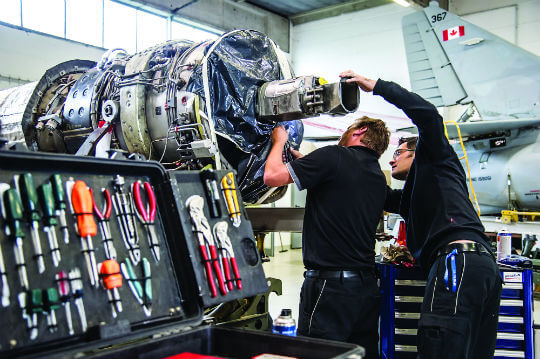
DA Defence has to be able to provide six aircraft a day—an aggressive target that it is working hard to reach by matching its flight hours to an efficient maintenance schedule.
Brandt noted that any future work would be done under a separate contract, and fulfilled with additional aircraft. “Germany is a very risk-adverse country,” he continued. “We have to provide absolute quality, to the world’s highest regulations. We believe we owe that to the customer, and are confident that it will translate well to other nations.”
While DA Defence continues its work in Germany under the gaze of other European nations, it takes a realistic approach to future planning. It is aware that the advent of the F-35 Lightning II will see military training step up yet another gear, and DA Defence is ready. It is set to acquire up to 10 Lockheed Martin Block 10 F-16A/B Fighting Falcons from an undisclosed source, realizing the benefits such a platform would bring to fourth and fifth generation fighter pilot training.
The company’s marketing director, Garrick Ngai, is relishing the prospect, but knows there is still a ways to go. “The F-16 is a U.S. military asset, so it comes down to State Department ITAR [International Traffic in Arms Regulations] approval,” he explained. “It’s a policy issue. This is being resolved right now, with a valid reason, to a legitimate end user to fulfil a legitimate contract with American allies.”
This wrangling has been going on for over 18 months and is understood to cover an initial fleet of four single-seat Block 10 A models and two B models, with plans for 10 in total.
“This transfer of F-16s is unprecedented,” continued Ngai. “We are working closely with the U.S. State Department and other stakeholders to secure the approval and transfer of the aircraft. It’s getting a lot of attention at very senior levels.”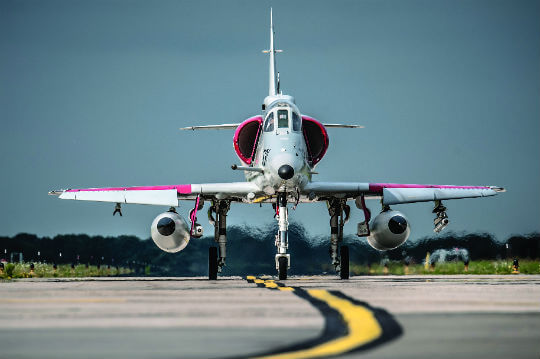
An A-4N taxis back to the ramp after a tangle with EF2000s in the “Red Air” support role.
While remaining guarded about what those future contracts could be, Ngai alluded that DA Defence is looking to fulfil the next Canadian contract to provide F-35-level training capabilities with what he called “a very high-end solution, with a very high-quality product” when it submits its tender to the RFP in January 2016.
Naturally, American companies are lining up to point the finger and block this move, but Brandt added that this is an important process. “We are happy that this is a stringent process. It keeps us honest and we like to have this oversight because it will result in another water-tight process that our competitors can only aspire to,” he said.
Of course, this could have been another piece of ‘marketeering’ from this dynamic company, so it made good sense to talk to the end user, the customer.

While DA Defence continues its work in Germany under the gaze of other European nations, it takes a realistic approach to future planning.
Awarding the stamp of German approval was the commander of the tactical flying group ‘Richtofen,’ LCol Gero Finke. “We are very happy having Discovery here in Germany. There are great benefits of having them on the base from a briefing and debriefing point of view,” he said. “It has proved to have a positive impact on our training. We profit from the synergy effects of the company having such good pilots, their experience counts, and we get on very well with everyone in the company. The A-4 is an excellent platform for our ‘Red Air’ presentation and there are talks of an even better, radar-equipped aircraft coming online.”
He indicated the new aircraft would be very beneficial for the German Luftwaffe in the future, especially as weapons training at Wittmund steps up with the transition from a tactical flying group to full fighter wing status next year.
“We look forward to a long future of working together in this excellent relationship,” concluded Finke.
Rich Cooper is a professional photographer and journalist who has been behind a camera for about 30 years. Recently, he founded the Centre of Aviation Photography, www.centreofaviationphotography.com.


